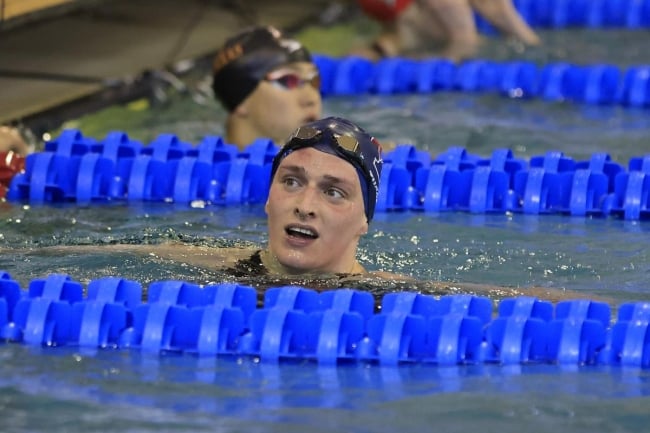You have /5 articles left.
Sign up for a free account or log in.

Lia Thomas of the University of Pennsylvania wins the 500-yard freestyle at the NCAA Division I Women’s Swimming & Diving Championship last week.
Justin Casterline/Contributor/Getty Images Sport/Getty Images
With March Madness in full swing, you may have noticed more than usual mainstream sports media coverage devoted to the National Collegiate Athletic Association women’s swimming finals last week. The coverage largely focused on “concerns” about the possibility of new records being broken by Lia Thomas, a varsity swimmer at the University of Pennsylvania who also set records for varieties of outrage generated by simply existing and thriving as an elite transgender athlete.
Thomas became the first known transgender athlete to win an NCAA Division I championship by winning the 500-yard freestyle last week. Before this event—and every other event in which she swam—swimmers are customarily introduced and cheered one by one, but the crowd reportedly was “noticeably quiet” for Thomas’s introductions. This silent treatment continued at the 500 free winners’ podium, with what seemed like deliberately more applause for every other finisher.
This was the culmination of months of reported team infighting around Thomas’s participation this season, with anonymous support and criticism coming both from swimmers and parents, and months of media coverage that at worst could be cringeworthy and reckless. Nobody wants to celebrate college sports like this.
In higher education, our discourse often skews progressive when it comes to transcending gender binaries in the name of inclusion. Which raises a question: Why, in this year, 2022, must records and championships only exist for male and female athletes? We should be celebrating Thomas, and yet, part of our problem seems to stem from the fact that there are only two podiums.
We should have seen this coming. Partway through Thomas’s standout season, in January, the NCAA faced criticism when it updated its transgender athlete participation policy and announced it would defer to the national governing bodies of each respective sport to set their own standards. In effect, they punted.
In doing so, the NCAA—along with the conferences and institutions that remain tenuously tied to it—squandered a golden opportunity to break its own record in terms of the number of genders eligible for recognition in its own record books. (That current record stands at two.)
We care a lot about championships and records in sport—maybe too much. The NCAA keeps records for male and female athletes, as do intercollegiate athletic conferences and colleges and universities. In swimming, USA Swimming keeps records, and even individual high schools and country clubs across the world keep records for the best times set at specific pools. Clearly, there are pool decks and aquatic arenas in the United States where we will never see space in trophy cases or walls dedicated to recognizing the accomplishments of trans athletes. But for the NCAA or any other institution that proclaims to be forward-thinking—and, yes, to their own stated ideals “inclusive”—we’re talking lines of code or extra columns in a spreadsheet. It’s not either-or, it’s additional, and for important reasons, it’s probably best that a category for transgender athletes be optional only for athletes who choose it. This should not be mandated.
Perhaps this has been considered already, and surely there are complications with the idea of recordkeeping that isn’t divided by the gender binary. It also gets complicated in certain sports. However, in digesting the collective controversy and outrage surrounding Thomas’s success in swimming, would it not help to allow for the mere possibility of viewing her athletic accomplishments as among the first in what will hopefully be a building history of transgender athlete achievement?
In a recent Sports Illustrated feature, Thomas identified herself both as a female swimmer and a trans athlete. I have deep reservations about putting Thomas or any future athlete in a category they don’t rightfully identify with, but in this case, she identifies as both. She may reject the idea of finding herself alone (or with very occasional company) on a third podium, and it’s possible some future trans athletes may reject this as well, especially if competing with cisgender athletes importantly affirms their own identity. But others may embrace it or welcome the opportunity to compete against Thomas’s records.
Let’s be honest that records and championships are gender binary in part because gender is constructed as a category of ability. Allowing women equal opportunity to compete is an equity and fairness issue and one of the key applications of Title IX.
By contrast, to use an imperfect analogy, the Paralympics have 10 categories for athletes with different levels of physical ability (or, in their words, differing levels of “physical impairment”) in swimming that aim to provide competitive parity both across gender and in specific events (e.g., freestyle, backstroke and so on). Athletes like Thomas prove that we may need to have more nuanced categories for gender in competition than two.
In boxing or wrestling, for example, weight classes are categories of ability. Age groups serve a similar purpose in youth sports, but weight and age are fluid. The sports establishment—and the state of Georgia, for example—seems to have difficulty recognizing that sex is not necessarily static.
Much of the discussion surrounding Thomas’s success this season wades into complicated matters surrounding physiology, kinesiology and, in this case, fluctuating policies around the duration of hormone-replacement therapy. These aren’t new debates, but the idea to offer individuals the opportunity to compete in neither male nor female categories would seem to sidestep all of this. It’s also uniquely possible in sports like swimming.
Indeed, as a former NCAA athlete and swimmer myself, I recognize that such an approach wouldn’t translate neatly in every sport.
In the NCAA’s January revision to its transgender participation policy, it cited the need to balance values of fairness, inclusion and safety. Fairness and safety are separate but related things, and it’s important to parse these rationales sport by sport if we’re to advance this conversation to benefit future athletes and fans.
In swimming there is no “safety” issue with allowing men, women or transgender athletes to swim next to each other. The “controversy” surrounding Thomas is about records and places on podiums. But there are other important nuances to consider that vary by sport.
For example, even if someone like Thomas were to compete for separate individual records, is it an advantage or disadvantage for others to swim against her as a fast pacesetter in the same heats? How does it affect competition for just one or a few transgender athletes to swim in their own heats?
There’s also the issue of what to do with relay events, or with sports like track and field and swimming, where individual events culminate in points toward the overall team. Again, the NCAA and governing bodies could get creative here.
On the “safety” side of the issue, team sports—especially contact sports—begin to get tricky. Think about slide tackles in soccer, a hockey check, a loose ball foul in basketball or a major penalty in water polo. Women’s wrestling is recognized by the NCAA as an emerging sport, with 45 teams and counting. Student athletes, parents and coaches will forever question the presence of transgender athletes in contact sports as a matter of safety.
While the issues will vary across different sports, there will be future trans athletes, and we—the royal “we”: institutions, leagues and governing bodies—need to do a better job to anticipate how all student athletes can have equitable opportunities.
This also includes the media. Some of the coverage around Thomas has been plainly awful, or worse, dangerous—a veritable “what not to do” checklist of GLAAD media guidelines for reporting on LGBTQ people’s stories. Some commentators referred to Thomas’s achievements as an “assault” on women’s sports, which is clearly offensive when describing a population (transgender college students) who we know are far more likely to be victims of assault compared to their cisgender peers.
Sports records and championships are fun to track, to bet on, to strive toward, but they’re not life or death. The way we report and write about trans people, however, can be life or death—especially when we report on young people, students.
It’s been reported that Thomas plans to continue training and swimming competitively toward the 2024 Olympics in the women’s category, so perhaps the next Lia Thomas is still Lia Thomas. I’ve never met her, but I wish her well and hope she feels supported by her teammates, her family and the campus community that we share. I also hope that we see a lot more athletes like her in the future who have the opportunity to compete and be wholly celebrated in the sports they love at an elite level.








